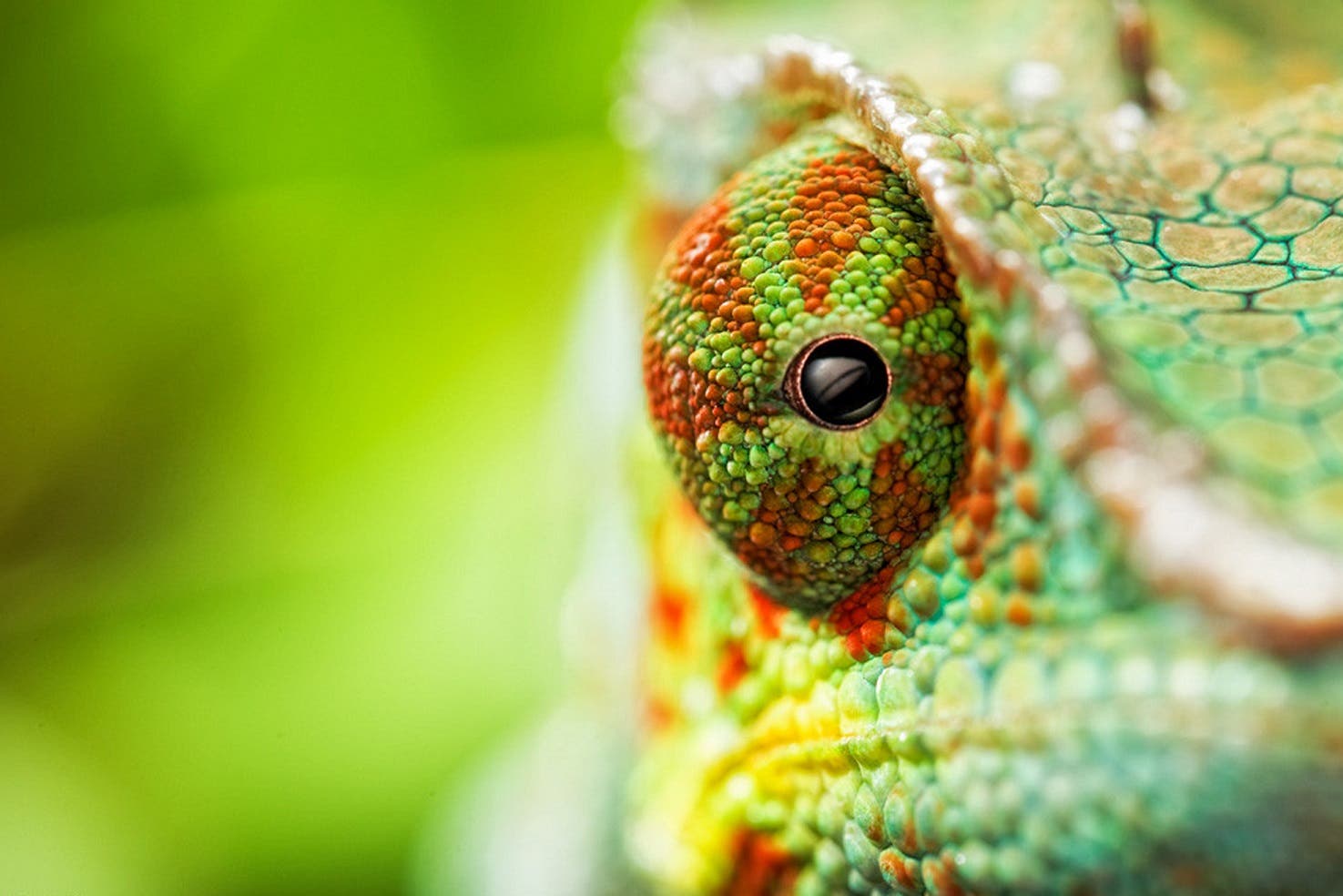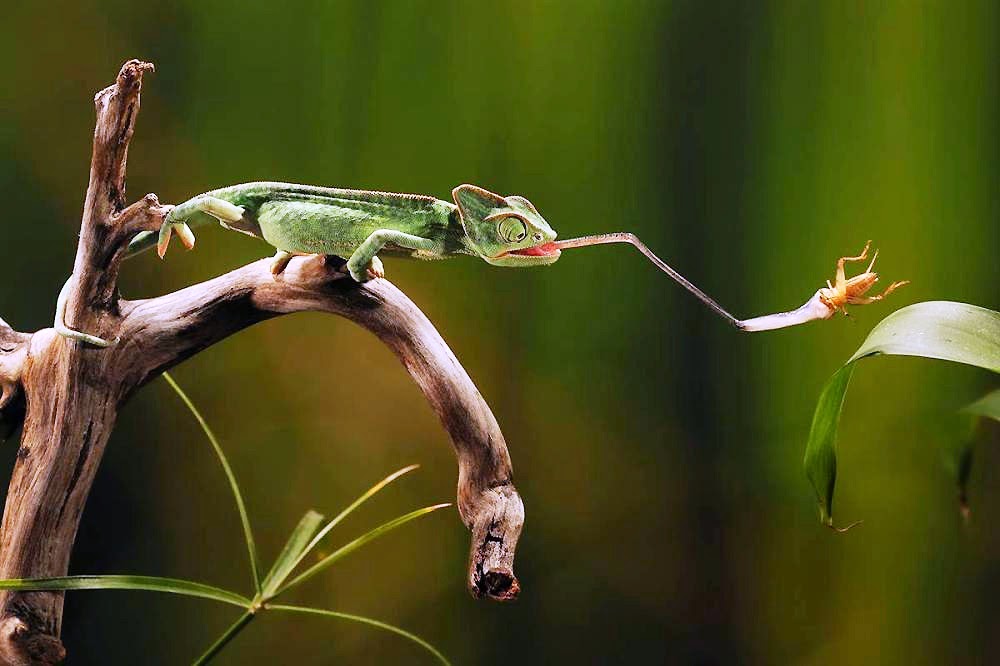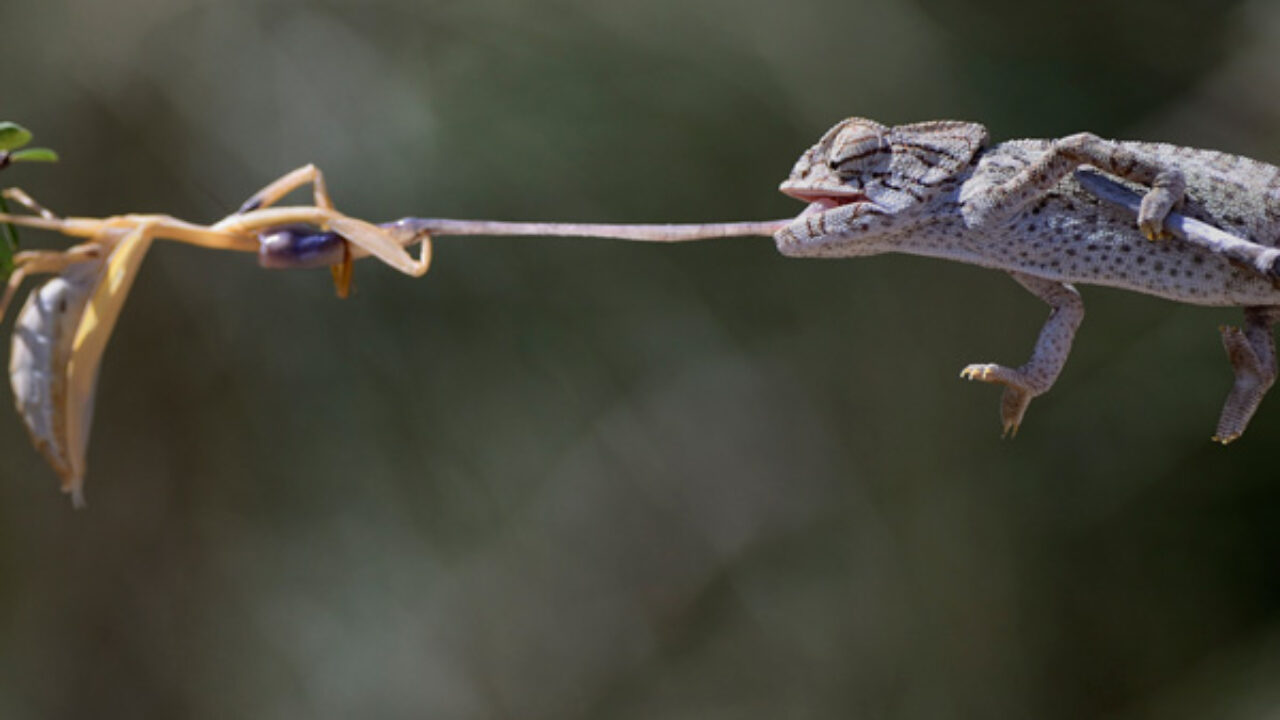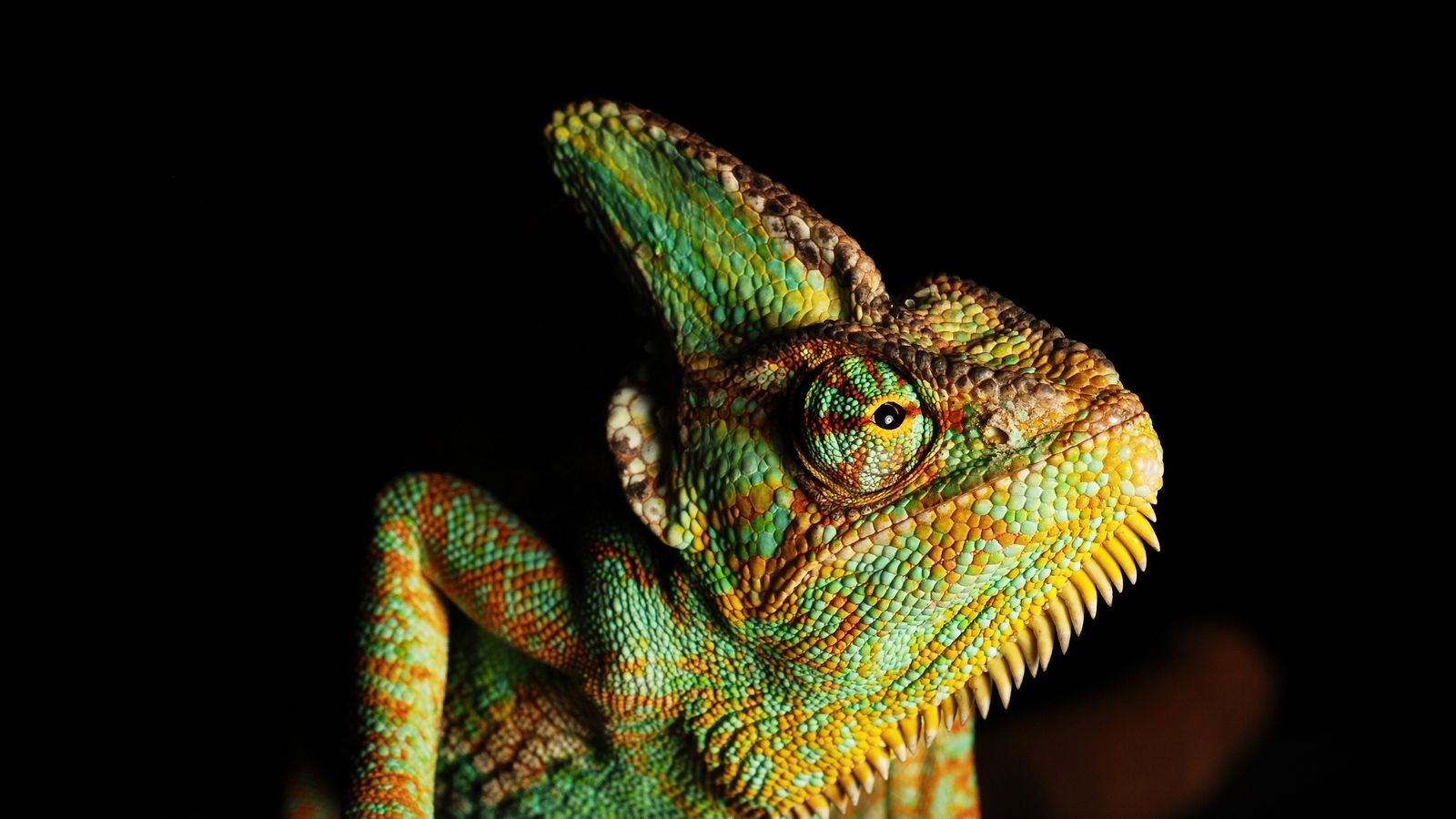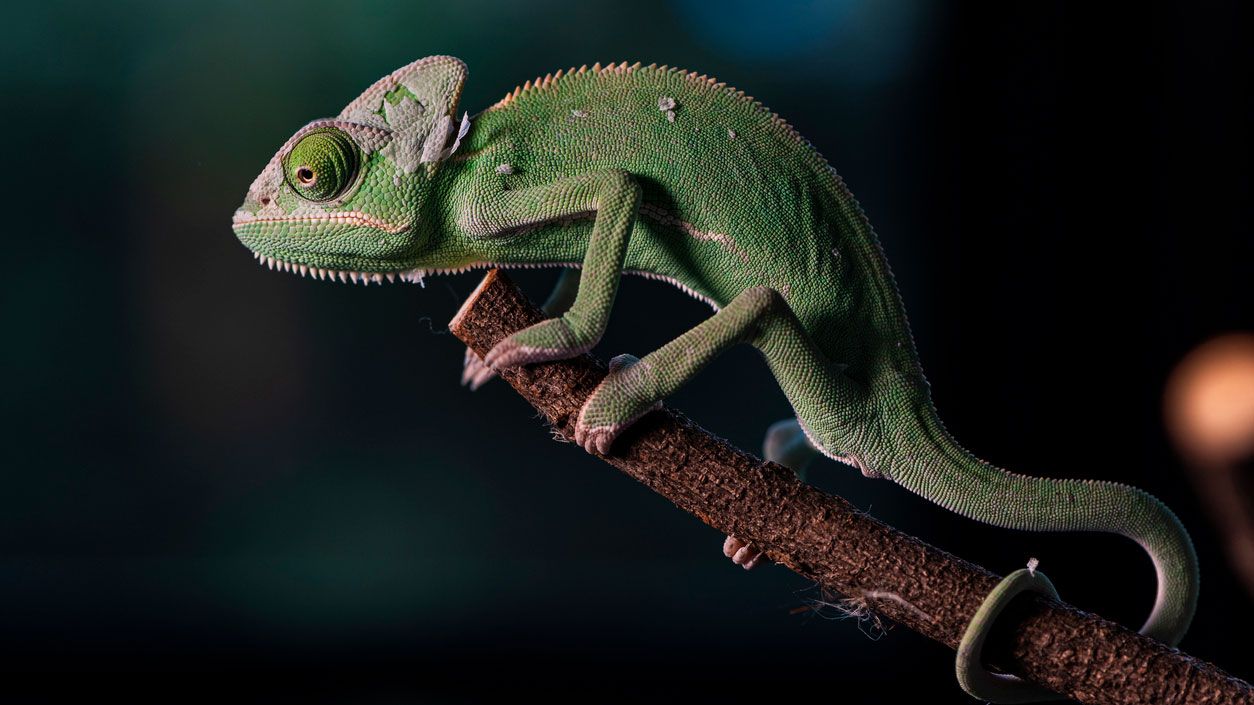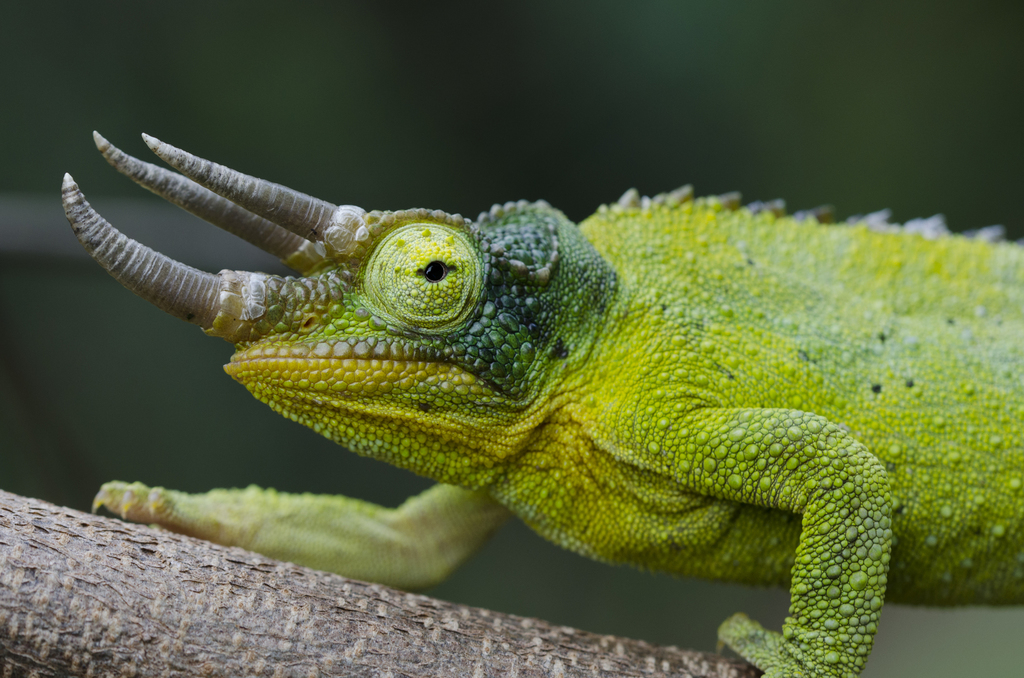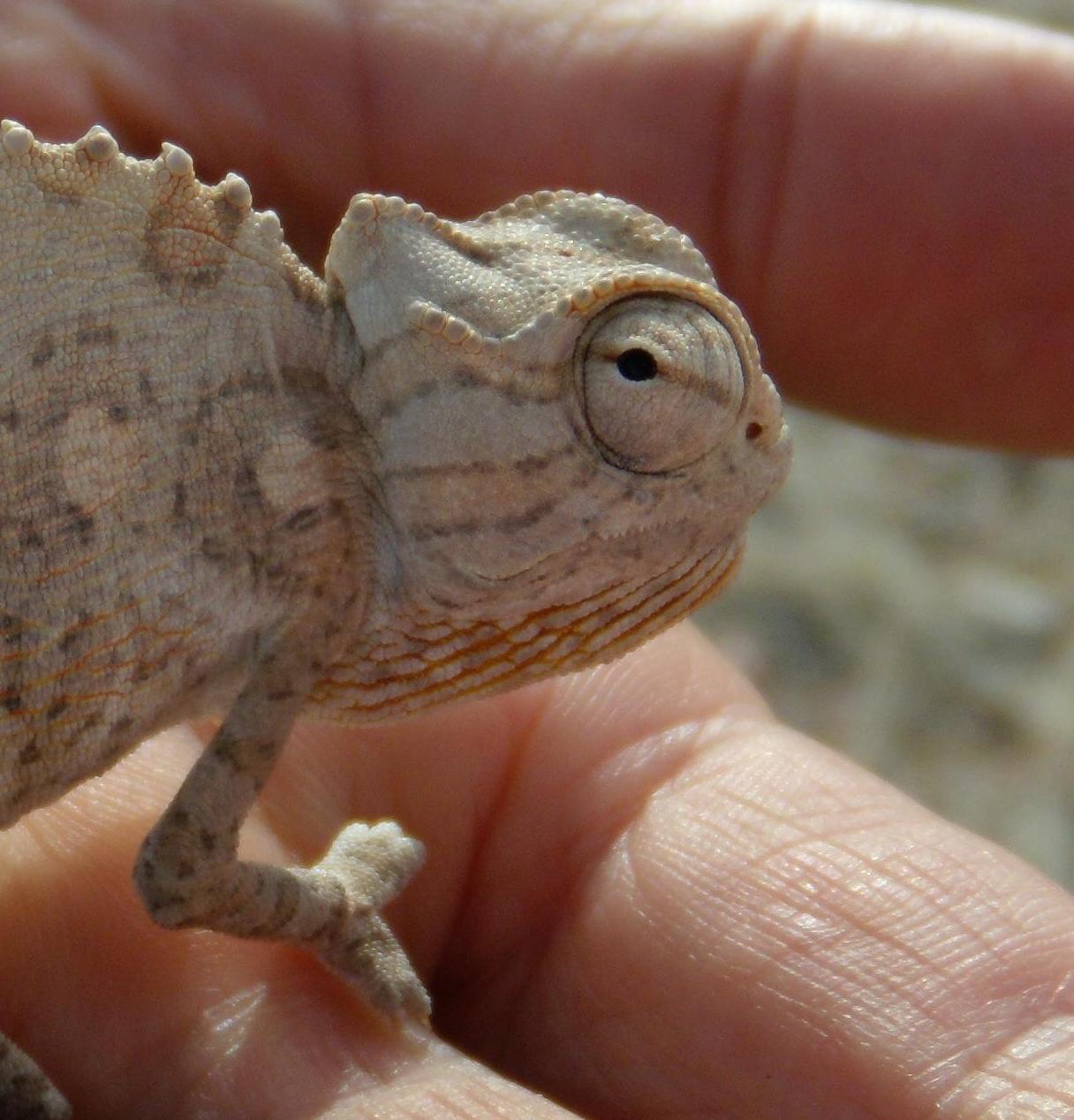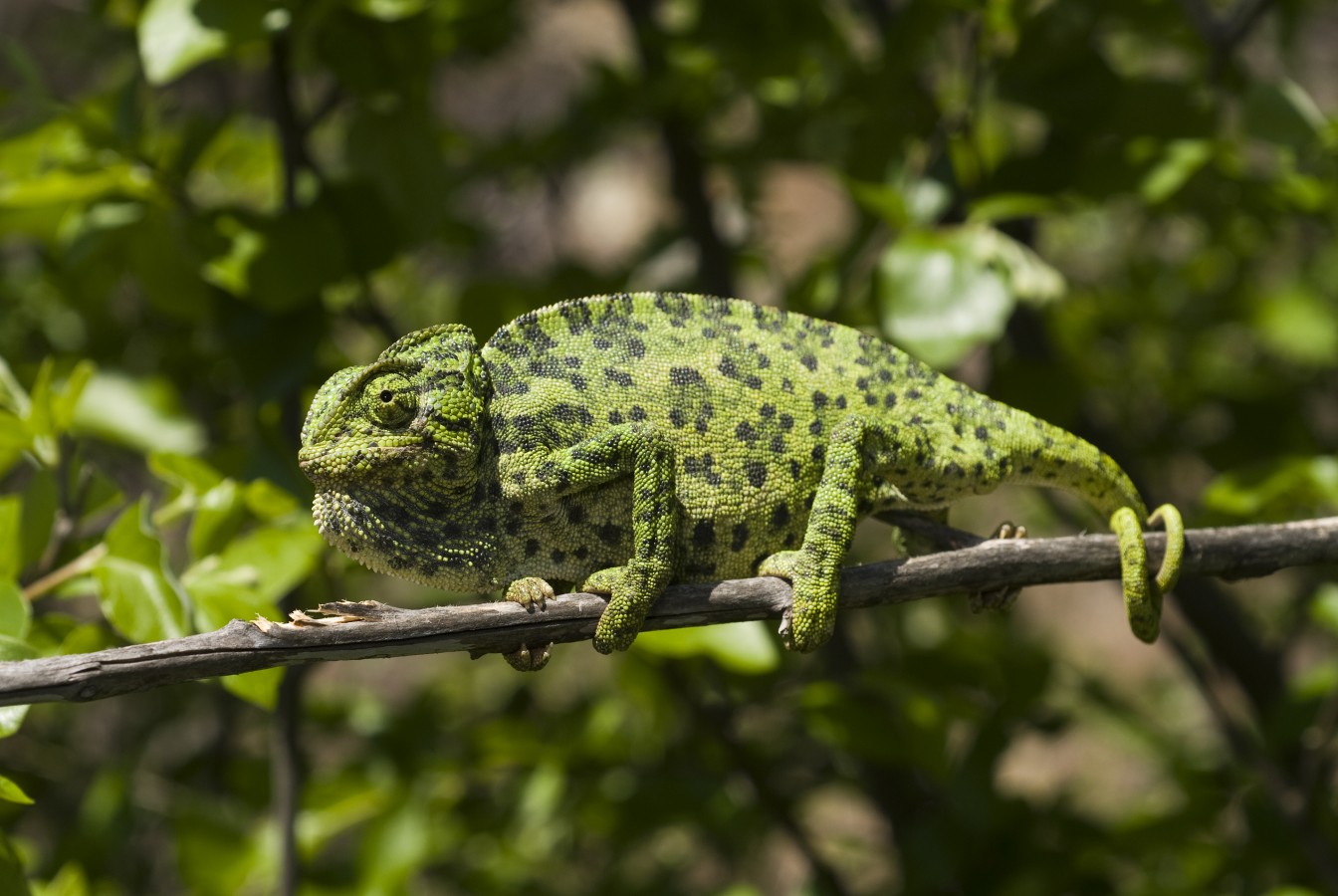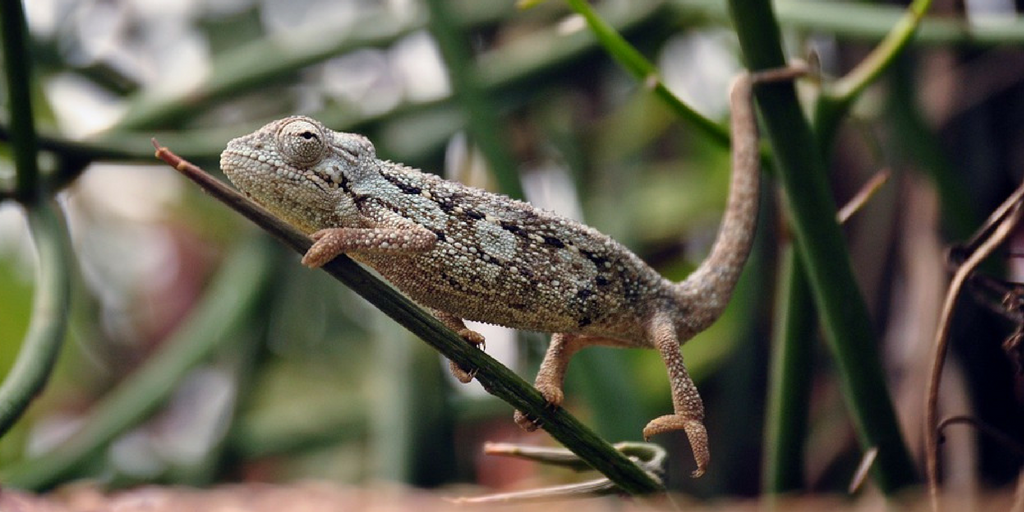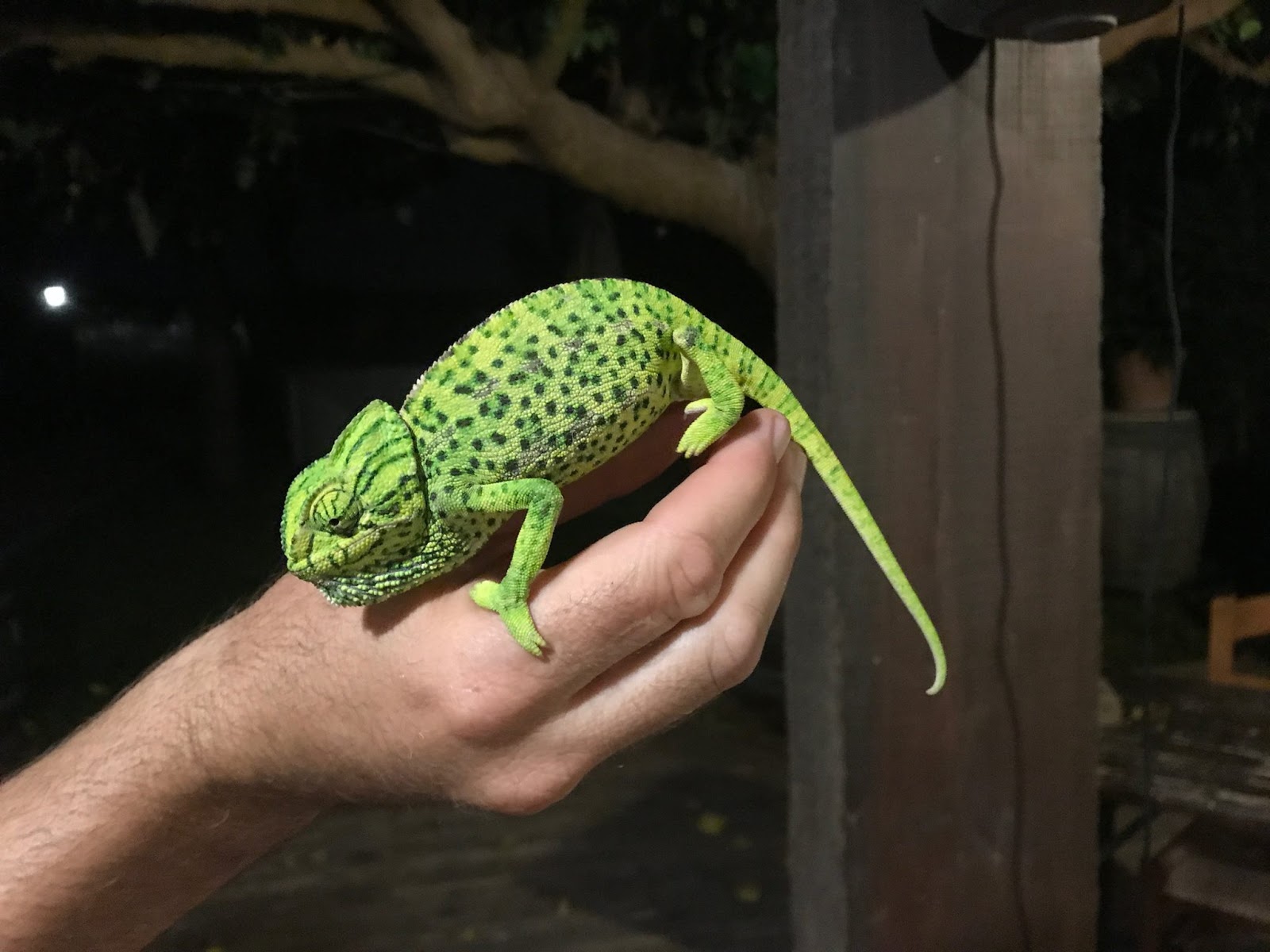Reptile of small size, with a calm temperament and not very sociable, among its most striking characteristics is the change of color according to its needs. In this article we will know the Characteristics of the Chameleon, Types, Care and More.

Etymology
The word "Chameleon" comes from the Latin "Chamaeleo" which in turn derives from the Greek "Kramai" which means earth or ground and "lion" lion which personifies a "Lion of Earth"
General Appearance of the Chameleon
The chameleon, direct family of the dinosaurs of the Paleozoic period, belongs to the family, Chamaeleonidae, of small scaly sauropsids (reptiles), class sauropsida, part of the order Squamata, of the suborder Lacertilia, of the infraorder Iguania, there are approximately 171 species of lizards.
They have hard and scaly skin, rich in keratin that gives them resistance, which for their restoration they need to change twice a year. Color changes are not by choice but by necessity (fear, hunger, etc.) activates the pigmentation found in cells located in the skin.
Depending on the family to which they belong, they can measure from 23 cm to 55 cm, their weight ranges from 20 g to 500 g, their lifespan also varies depending on the group they belong to, approximately 5 to 15 years.
The male is slightly larger than the female, their temperament is calm, they are shy and not at all sociable. They tend to move from side to side when they walk with a gait that is considered quite uncomfortable. You can remain motionless for several hours.
It has a prehensile tail that allows it to grab and attract objects, it helps to provide stability when climbing trees and clinging to branches.
Features
The chameleon is part of a family of lizards that is characterized by having an angular head, a tall and narrow body, its tail is prehensile as is its tongue. The males have ornaments, a tuft or horns on the head or nasal protuberance that they use when they must defend their territory.
There are common characteristics that represent the most noticeable features of a family, among them we can mention the shape of their legs, ears, eyes, tongue and the most striking color change.
The paws
The family has 4 legs with five toes distributed as follows: 3 toes outwards and 2 inwards, their front toes are glued together, and they have a soft padded layer in the center, they are provided with strong claws that allow them to grip the Climb trees.
Another aspect that draws attention is the distribution of the claws, on their front legs they have two claws outwards and 3 inwards, on the rear legs they are located opposite to the front legs.
The ear
This animal is not deaf, despite not having external ears, they can perceive sound waves and vibrations, with a range of frequencies up to 200Hz to 600Hz. Useful feature to detect possible prey for food or enemies on the prowl.
The eyes
The chameleon's eyes are large, covered by eyelids that leave a small central opening where the pupil and iris can be located, which can move independently of each other. Being one of the most outstanding characteristics among reptiles.
Their visual range is very wide around 180 degrees horizontally and 90 degrees vertically, these qualities provide them with a high capacity to distinguish depth and analyze the environment. Your Eye Location gives you a panoramic view by getting a nearly 360 degree radius and you have a blind spot just behind your head.
Its eyelids are joined together through a single rounded structure, which almost completely surrounds the eye, creating a conical shape. This eyelid-eye union allows it to follow each movement. Another curious fact occurs when it locates its prey, both eyes are directed in the same direction, offering it a stereoscopic vision and a perception of the environment.
It has excellent daytime vision where they obtain clarity from the environment, this is thanks to the presence of cones in the retina, but the absence of rods in the retina creates a lack of night vision. Reason why they hunt by day.
Its good vision allows it to see insects or small animals for its consumption at a distance (between 5 and 10 meters) and also detect ultraviolet light.
Language
Protractile organ, which stands out for the speed and length it can reach, on many occasions it can reach a length that can exceed its own body, becoming 1,5 to 2 times its size and in fractions of a second go from 0 to 96 km/hour The length will depend on the species.
It has a sticky tip, becoming a sucker preparing it to hunt all the prey it requires, such as small animals and insects, which are immediately ingested at an amazing speed that makes it difficult to observe in detail. It can take 0,07 seconds to reach its prey.
Color change
Generally, the color change occurs in response to a stimulus, contrary to what is believed, it is not an act that is performed at will but by necessity, taking into account a series of situations that we will classify as a psychological situation (relationship or communication) or physiological (time of day and temperature).
Another false belief that they are colorless or that they change color to be in union with the environment, when in fact it is their way of communicating with each other, to indicate any situation that is happening, such as warning of a predator, change in the environment, fighting or rivalries, courtship, etc.).
The color indicates whether they are scared or angry and ranges from red to green. Not being its main objective, change allows it to go unnoticed in the environment.
This pigmentation occurs due to specialized cells distributed in several layers of the dermis and allows to control the intensity of brightness, hue and the markings that differentiate chameleons through contracting or expanding the pigment cells.
The cells responsible for pigmentation are as follows: Chromatophores are found in the upper layer and contain yellow and red. Guanophores are below the chromatophores, it contains a colorless crystalline substance, called guanine, it also radiates the blue color of the occasional light, the work together creates the combination of colors.
In the lower part are the Eumelanin that gives the dark color, rich in melanophores that regulate brightness. According to recent studies, it was observed that chameleons can change the position of the cells by relaxing or adjusting their skin.
Through the color and its brightness, the dominant male can be identified and they are usually more attractive to the female. The females through their colors accept or reject a suitor or indicate being pregnant.
Food
Diurnal chameleons eat a variety of non-chewing insects. The larger species manage to consume even birds and lizards. Other groups like plant matter. Its menu is concentrated on grasshoppers, crickets, mantises, insects and lobsters.
It basically feeds on arthropods and small vertebrates. In captivity, they can eat fruits such as papayas, bananas, and even young rodents. But that diet is only valid for adult animals: the young are almost exclusively insectivores that are processed by strong stomach acids.
Water is of great importance for the development and health of chameleons. To ingest the water they use the tongue or inhale it.
Habitat and distribution
They can be found in different areas from the tropical jungles to the driest areas in thickets, forest areas, on the ground under the leaves, in the trees using their tail and legs, they can be found in almost any environment, both the above described as in mountains, jungles, savannahs and even in deserts, semi-deserts and steppes.
Chameleons live in Africa, Madagascar, Spain, Portugal, Sri Lanka, India and Asia Minor, in tropical forests.
Reproduction
Chameleons reach sexual maturity between 4/5 months and 8/10 months (depending on the species), once they have courted and the female decides who her partner will be and they carry out the fertilization process.
In the reproduction of the chameleon we must take into account the species and the variables that each family entails. There are ovoviviparous species, which means that the mother protects and incubates the egg inside the body, they can have from 8 to 30 offspring, in a gestation process of 4 to 6 months.
Other groups of species that do lay eggs are oviparous and their incubation time is from 4 to 24 months depending on the species. The size of the chameleon indicates the number of eggs they will have, the variability is great, the small ones can lay from 2 to 4 eggs and the largest ones from 80 to 100 eggs at a time.
After 3 to 6 weeks of fertilization, the female lays her eggs, makes a hole in the ground of 5 to 30 cm, depending on the needs of the species, proceeds to bury the eggs and leaves the place, her gestation time will be 6 to 8 months depending on the species.
Newborns look like a miniature version of an adult animal. They are prepared to lead an independent life from the moment they are born.
Behavior
They are diurnal animals, a time when they are most active, they cannot be classified as the most active hunters, but if they have infinite patience, they can last for hours motionless or sitting waiting for their prey.
It is recognized that they are solitary animals, they are usually very aggressive with members of their own species. They only socialize when it is time for mating when the male goes out in search of the female. Generally the female does not like to be touched, the male will seek to stand out through her colors. The female may hurt the male to keep her down if she thinks the time is not right.
Although chameleons are not violent animals, they tend to defend themselves if provoked, even biting. Their bite is not dangerous, you just have to disinfect the affected area.
Species
The varieties of species exist is unimaginable with such marked differences from size, reproduction, its evolution is marked by its environment, the most outstanding are:
Panther Chameleon
The Panther chameleon (Furcifer pardalis) belongs to the Chamaeleonidae family, they are located in the North and East of Madagascar, their diet is based on crickets, beetle larvae, grasshoppers, mealworms, waxworms. The male is larger than the female, the size of the male is approximately 50 cm and that of the female 43 cm.
This species is characterized by its striking colors, obtaining the title of the most beautiful lizard in the animal world. Males are more attractive than females. They have an average lifespan of 10 years. They are resistant and adapt easily to the environment.
The female obtains a dark coloration to indicate that she does not want to mate, she has already nested several times or is in that process, after laying the eggs the female usually lives 2 or 3 more years. They are very popular as pets.
Fischer's chameleon
Fischer's chameleon (Kinyongia fischeri) is part of the family: Chamaeleonidae, they are located in East Africa, their diet is based on crickets, cockroaches, giant worms, mice. The male can measure approximately 40 cm and has a 3 cm horn that comes out of his forehead, the female can measure between 35 to 40 cm, the female's horn is barely noticeable.
It is characterized by the exaggerated development of its face, it can be several centimeters long, its predominant colors are green, white and yellow. Another quality is its resistance to humidity and high temperatures. In a clutch they can lay 10 to 20 eggs that will hatch around 5-6 months.
Helmet Chameleon
The Casco chameleon (Trioceros hoehnelii), It comes from the Chamaeleonidae family, they can be found in East Africa, Uganda and Kenya, their diet consists of small insects and spiders. Of medium size, males are larger than females.
It presents a great scale of colors. When basking in the sun, it shows a dark coloration since these colors absorb heat. Physically it is different from other species, they have a single horn, their back is toothed and they have small spikes on their necks.
The females have a cap and their tail is wider. Males display bright colors to impress the female and intimidate her rivals. These couples will continue together until the birth of the children. Another characteristic to highlight is the length of its tongue, which can be equivalent to the length of its body.
Jackson's Triceratops
The Jackson's triocero (Trioceros jacksonii), is part of the Chamaeleonidae family, they are located in Kenya and Tanzania, their diet consists of small insects. Its average size is 30 cm. They usually call it three-horned. The youngest reach their sexual maturity in 5 months.
Their lifespan varies but the male lives longer than the females. Its main color is a bright green and rarely blue and yellow. Their gestation period lasts from 5 to 6 months, they are ovoviviparous and give birth to live creatures, generally between 8 and 19 offspring.
Trioceros melleri
Meller's chameleon (Trioceros melleri), are from the Chamaeleonidae family, are located in Madagascar, their diet consists of insects, lizards, worms, spiders, small birds, caterpillars. The female is smaller than the male, which can measure approximately 60 cm and weigh 600 grams. Females have tiny dorsal spikes.
The sides of this chameleon are black, yellow or green and brown on the rest of the body they have an intense green color that can change to a varied range of green, black and other different colors with white stripes.
In a clutch, the female lays about 80 eggs at birth, measuring 10 centimeters long. Their lifespan is 12 to 20 years, they are usually one of the longest-lived species. His head is smaller than his body.
Chameleo Namaquensis
The namaquensis chameleon (Chamaeleo namaquensis), comprises part of the Chamaeleonidae family, can be found in the Namib Desert and South Angola. Their diet consists of beetles, crickets, lizards, scorpions, small snakes. They have great resistance and adaptation to survive desert conditions.
They usually have a kind of heat reserve for those long cold nights, a process that they do by darkening in the shade, turning gray during the day. You can release your toes from your paws this helps you slide faster on the ground. He is a good hunter. The females usually lay 20 eggs that will take 100 days to hatch.
Parson's chameleon
Parson's chameleon (Calumma parsonii) are from the Chamaeleonidae family, they can be located in the East and North of Madagascar. Their diet consists of small insects. Its size is 68 to 80 cm, it is one of the largest and strongest species that exist. Their senses of hearing and sight are well developed. Its lifetime is 7 years.
They present a beautiful turquoise color, yellow or orange eyes. It has a plush appearance thanks to the fact that its scales are small and even, it can change color at will in a time of 15 to 20 seconds. You can change your sleeping position. His tongue is bigger than his body.
In their reproduction they lay the amount of 50 eggs every two years, the estimated time for their formation is one year in certain cases they can reach up to two years. The young are formed only to learn how to survive in the environment. It is not recommended as a pet and its export is prohibited in its country of origin.
Pygmy Chameleon or Rieppeleon Brevicaudatus
The pygmy chameleon (Rhampholeon brevicaudatus), is part of the Chamaeleonidae family, is found in the Usambara areas, Uluguru Mountains of Tanzania, its diet consists of small insects. Its size is 7 centimeters long. They are known as bearded chameleons, because they have a small beard made up of scales that protrude below their mouth.
Its color is mostly brown, changing intensity to adapt to the environment, it resembles a dry leaf, especially when it goes to sleep outdoors. Change its colors from green, orange, black and brown. His tongue is longer than his body.
Yemen chameleon or veiled chameleon
The Yemen chameleon (Chamaeleo calyptratus), is part of the Chamaeleonidae family, lives in Yemen and Saudi Arabia, its diet is based on leaves, fruits and flowers. The male measures 60 cm and the female 30 cm. It enjoys great popularity. They are green in color which changes if there is a change in their surroundings to a darker green or red.
Both the male and the female have a helmet on their heads, the males have spurs on their hind legs that grow as the chameleon matures. In each clutch you can lay between 20 to 70 eggs.
Smith's Dwarf Chameleon
It belongs to the Bradypodion family, it can be located in southeast Africa, its food is small insects. It can hide in the environment when it is in danger, unlike other chameleons this species if it can do so at will. It is in danger of extinction due to the change that its environment is presenting.
Ituri Chameleon
It belongs to the Bradypodion family, it can be found in the forests of Rwanda, Burundi, Uganda and the Democratic Republic of the Congo, its food is small insects. Its size is 20 cm. Its predominant color on its body is green that can vary in intensity and are combined with black spots.
Drakensberg Chameleon
It belongs to the Bradypodion family, they are found in the Drakensberg mountains, in South Africa, hence its name. There are two subspecies, of which the most famous is the emerald dwarf chameleon, which has a very bright green color.
tiger chameleon
It belongs to the Archaius genus of the Chamaeleonidae family, being the only existing species, it inhabits the Seychelles Islands and lives in forests with a high density of vegetation. Its size is 16 cm. It is the least strong compared to other species, it is elongated and thin in tails and legs.
Predators
The chameleon presents as many dangers as there are species, they are at the bottom of the food chain. Generally it can go unnoticed in its environment as it has tones similar to the habitat where it is found. We will mention some common predators among the species.
The snake
It presents a great threat to chameleons as both on the ground and in the trees they can be hunted by a variety of snake species. They mostly eat the eggs or small hatchlings.
Birds
Like snakes, any bird can be their enemy, generally the bird looks for them to hunt in the treetops, thanks to the colors of the chameleons they can be confused with the foliage disorienting the birds. The main enemies are shrikes, chickadees and hornbills. They are also looking for the eggs or hatchlings.
The man
The man is a big problem. We can mention the poachers and the commercialization of exotic animals, the drainage of the land through chemicals and pesticides, the forest fires that have devastated a large area of land, all this and more have altered the ecosystem of the chameleon. Causing many species to be endangered or extinct.
State of conservation
According to the IUCN (Red List of Threatened Species of the International Union for Conservation of Nature) many species are in danger, we can mention the Archaius tigris, the Smith's dwarf chameleon, the Brookesia bonsi and the Brookesia decaryi, Parson's chameleon among others.
The Chameleon and its Symbology
We can highlight the qualities of this animal, its patience, adaptability, the changes that must be generated and personal evolution. Taking into account the ethical and psychological order to the cosmic order, allowing directing interests and allowing us to observe ourselves and the environment as one.
Chameleon Totem
It represents change, decision making and the patience to analyze and evaluate the tools necessary to survive. We can be like the chameleon if we try: patient, curious, stable and adaptable.
The idea that the chameleon can change at will reflects that we can change just the same with a little effort and will to make the change satisfactorily.
Dreams
If you dream of a chameleon, it indicates that there will be a change in your life that you will have to adapt to since they represent adaptation, although change is required, you must be flexible so that change is not difficult.
It may also be that you feel hidden, if you do not like to feel that your life is being overlooked, change the colors of your life, allow yourself to grow, live, even make mistakes, because everything lived is a life experience.
Mythology
According to tradition, it is said that the chameleon was one of the first inhabitants of the earth when the waters had not yet parted. It was the task of informing the Gods that man would be immortal. But because of his slow pace, his apparent moderation and laziness, he came after the lizard. His objective being contrary to that of the chameleon, he informed the Gods that the man would be mortal. If man had arrived in time, he would be immortal.
Culture and art
The word chameleon is often used in colloquial language as that inconsequential person who changes his behavior and characteristics to the circumstances.
In some African tribes, it represents a sacred animal, seen as the creator of the human race. It does not die, and they are objects of superstition when they find one on the road, they carefully push it aside, fearing curses.
It is said that they can change luck from good to bad, other tribes say that if you are bitten by a chameleon you will be infertile, it is thought that sorcerers manipulate them to send bad energies to families. They are usual characters in fables, where they generally represent slow, cunning and unreliable creatures.
At the acting level, reference is made to the actors who personify diverse characters with great professionalism and dedication, displaying their skills.
The Chameleon as a Pet
Yes, there are species that can be bred in captivity and adapt to the environment that is being created, but they will never be domesticated, they are considered exotic animals. It can live up to 10 years in captivity.
It could be said that the chameleon is the anti-pet since it does not comply with the concept of a pet, we cannot touch, hug or caress it, but if we decide to have one, one bred in captivity is preferable because they are easier to care for.
A lot of care is required because these species are generally shy, not at all sociable, they get stressed easily, so you have to invest in time, patience and a welcoming space for their stay. Children should not handle it without supervision.
Some species such as Furcifer Pardalis and Chamaeleo Calyptratus are the most suitable to adopt as pets. Keep in mind that you must spend time and require a lot of attention.
All chameleons have parasites that multiply, weakening it, due to the route that this animal generally has to travel until it reaches its final destination, if it is not taken care of, it could die.
It is necessary that when an animal is acquired, subject it to prolonged quarantine, place it in a closed terrarium with few things and discard after time everything that was used in that period and have on hand the necessary treatment for parasites and carry out various laboratory tests. .
During the acclimatization period, you should control everything you eat and drink to control that you receive the necessary nutrients and check for injuries. A plant should be placed on it so that it can hide and not get too stressed.
Tips for Caring for a Chameleon as a Pet
They are territorial animals, therefore they should not be placed with another of the same species to avoid damage, red and white colors should not be placed near the chameleon because they stress it. They should be in a space that is not very busy and we should not touch it a lot.
His house
Glass terrariums are not recommended for them, well-ventilated terrariums with at least one or two sides with grids are preferred. It is recommended to have at least these measures 50x50x90 if it is bigger better so that it has space to move, it should be decorated simulating nature, place trunks, leaves, foliage to hide, not very large stones.
It is important to use disposable materials to place on the floor and certain areas of the terrarium, to facilitate cleaning and keep your space clean.
light and heat
Special UVB/UVA tubes should be placed for lizards to give them light 10 hours a day. It should get a bit of sun and natural light, we can place its cage near a window, but we must be careful of drafts. As for the temperature and humidity, they vary from species to species, we must be aware of the characteristics of our pet and that it must be adjusted both in the morning and at night.
Food
The water must be supplied through a drip system that falls on a leaf so that he can hydrate himself. Its basic food is insects, crickets, worms, flies, cockroaches, all alive and be aware that it does not have pesticides or any other chemical. It can be added to their food with special calcium and vitamin supplements for reptiles.
Do not leave without first reading the following articles:

